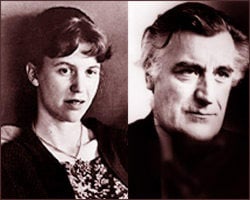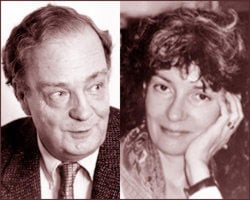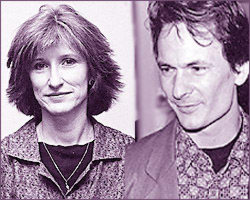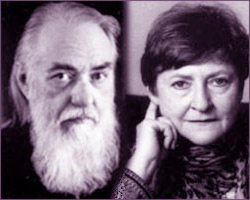Love poetry is about as old as love itself, from Homer’s vision of Penelope’s steadfastness, to the biblical Song of Solomon, to Shakespeare’s sonnets for his "Dark Lady" (or, some speculate, Dark Lord), to Keats’s love songs for his own depression. Most poets, at one time or another, write their way into the hearts of their chosen partners, but sometimes something slightly more unusual happens: two poets fall in love with each other.
Contemporary poet-couples join a long tradition. In 1846, the Victorian dramatic monologist Robert Browning married the gifted poet Elizabeth Barrett. The Brownings' fifteen-year marriage yielded some of the best-loved poems in the English language: his "Fra Lippo Lippi" and her Sonnets From The Portuguese, among others. The great Russian poet Anna Akhmatova had an ill-fated marriage to the young poet Nikolai Gumilyov. W. H. Auden fell into a fiery, at times damaging, romance with the poet Chester Kallman, who was fourteen years his junior. Their relationship produced many collaborations, including the libretto to Stravinsky’s famous The Rake’s Progress.
More recently, former U.S. poet laureate Robert Hass married avant-garde hero Brenda Hillman. The union of the influential James Tate and Dara Wier has propelled the University of Amherst MFA program for years. Countless poets have fallen in love, shared, and sometimes ruined, each other’s lives.
Sylvia Plath and Ted Hughes

Sylvia Plath grew up in a New England society family. After graduating summa cum laude from Smith College, she was awarded a Fulbright to study for two years in Cambridge, England. Waiting for her there—though neither of them knew it—was Ted Hughes, an ambitious, young British poet eager to make his reputation. Less than four months after the two met, they were married.
After having won nearly every honor a British poet can, including the poet laureateship, Hughes published his last book of poems, Birthday Letters, shortly before his death in 1998. In it, he writes openly for the first time about his relationship with Plath, who committed suicide in 1963. He writes about their romance with a hint of providence. In the poem "Fulbright Scholars," Hughes describes the moment he learned the new Fulbright scholars had come to town:
Where was it, in the Strand? A display
Of news items, in photographs.
For some reason I noticed it.
A picture of that year’s intake
Of Fulbright Scholars. Just arriving—
Or arrived. Or some of them.
Were you among them? I studied it,
Not too minutely, wondering
Which of them I might meet.
I remember that thought. Not
Your face. No doubt I scanned particularly
The girls. Maybe I noticed you.
Maybe I weighed you up, feeling unlikely.
Noted your long hair, loose waves—
Your Veronica Lake bang. Not what it hid.
Also familiar is Plath’s depression, which colored, or darkened, her marriage to Hughes as well as her writing. She was, doubtlessly, an extremely passionate person, impulsive, wild, intense. Her incredible journals show her constantly wrestling with her mind to write better, get happier, and win the competitions she imagined going on in love and literature. Here is her extraordinary description, written on February 26, 1955, of the night before, when, at a Cambridge party, she and Hughes first met:
Then the worst happened, that big, dark, hunky boy, the only one there huge enough for me, who had been hunching around over women, and whose name I had asked the minute I had come into the room, but no one told me, came over and was looking hard in my eyes and it was Ted Hughes.
There is a similar intensity to both Hughes and Plath’s renderings of their early encounters, perhaps the same feeling of providence. In Plath’s journal, we see a woman confident in her powers and in her sexual appeal. We see Hughes as a big brute of a man, something Plath seems to have liked.
A page later in the journals comes Plath’s account of the now famous encounter occurred a little later at the same party. Plath’s version of it is truly riveting:
…and I was stamping and he was stamping on the floor, and then he kissed me bang smash on the mouth and ripped my hairband off, my lovely red hairband scarf which has weathered the sun and much love, and whose like I shall never again find, and my favorite silver earrings: hah, I shall keep, he barked. And when he kissed my neck I bit him long and hard on the cheek, and when we came out of the room, blood was running down his face.
That same lusty violence occurs throughout Plath’s mature poetry—almost all of which was written during her years with Hughes—especially in late poems like "Daddy," which conflates the father figure and the husband.
It seems that one likely outcome of two poets falling in love is corresponding metaphor in the writing of the two lovers. Plath sets something in motion here, a call for the meaning of the blood "running down his face." Thirty years later, Hughes answers, in the poem "St. Botolph’s":
You meant to knock me out
With your vivacity. I remember
Little from the rest of that evening.
I slid away with my girl-friend. Nothing
Except her hissing rage in a doorway
And my stupefied interrogation
Of your blue headscarf from my pocket
And the swelling ring-moat of tooth-marks
That was to brand my face for the next month.
The me beneath it for good.
Notice that Plath’s headscarf has gone from red to blue—even for poets, or perhaps especially for poets, who are experts in the art of their own perspectives, love is a game of conflicting subjectivities. But Hughes’ answer to Plath’s promise of a scar was to admit a scar, although one that would ultimately not show (though it would dog him throughout his life, until finally coming clean in his last book).
We could look further into Plath’s poems to find the marks that Hughes made, but most of those paths have been trodden flat. Suffice it to say that Hughes haunts many of the poems of Ariel, in which Plath tries hard to see herself as separate from what she calls, in "Tulips," the "little smiling hooks" of her husband, their two children, and, most importantly, her long-dead father. Early in their lives, these two gifted poets wove each other into the fabrics of two monumental and tortured poetries. The world has yet to recover.
Donald Hall and Jane Kenyon

The story of Jane Kenyon and Donald Hall—as Hall tells it in his memoir The Best Day The Worst Day: Life With Jane Kenyon—is a history of quiet, intense domestic bliss and deeply felt loss and grief. By the time they met in 1969, Hall was already an accomplished poet, one of the founding editors of The Paris Review, and a tenured professor at University of Michigan. Kenyon was his student in a course he taught annually called "An Introduction to Poetry for Non-English Majors." She was just about twenty-one years old.
While this might sound like the setup for a collegiate scandal, in fact, as Hall says, "I never made Jane’s acquaintance among the 140 students." It wasn’t until a year later, when Kenyon was twenty-two and enrolled in Hall’s poetry workshop, one of twelve students, that they began to notice each other. Hall describes the young Kenyon, who would later be known as a poet who unflinchingly confronted her bouts with depression in her poems, as lively and happy: "She charmed and argued, swore and praised and denounced, laughed and teased with the rest of them." At this time, Hall was just getting over a divorce from his first wife, and Kenyon’s first serious relationship was deteriorating.
The two began seeing each other in 1971, at first casually, not exclusively, hedging their bets: "Neither Jane nor I said ‘I love you.’ Maybe both of us feared that ‘love’ was a synonym for ‘pain.’" But soon things became more serious. They began to discuss marriage, cautiously, shelving the idea again and again. But, following a serious fight after which they feared they might lose each other, they made a decision: "’Maybe we should get married,’ I said. Jane nodded, and we embraced without speaking."
After this tender admission, Hall gives a clear and moving an account of the uncertain territory into which a marriage can thrust two people: "Surely the dread of separation has accounted for more than one engagement, and doubtless there are better reasons for getting married—but all marriages start in ignorance and many from need; what matters is what you do after you marry."
And what the two of them did has come to matter to many people. They left Michigan and moved to Hall’s ancestral home, Eagle Pond Farm in New Hampshire, which Hall has made famous in poems and prose. And there—amidst struggles with Kenyon’s bipolar disorder, Hall’s changing career, dogs and cats, Kenyon’s rising fame, Hall’s cancer, and Kenyon’s fatal Leukemia—they lived happily and quietly, and they wrote. Kenyon’s mastery of her art grew over several published books, eventually culminating in the posthumous Otherwise, and Hall wrote his middle poems, the most memorable of which may be the elegies of Without, the book he began during Kenyon’s illness and finished after her death.
Hall and Kenyon did a good job of navigating the poet-couple pitfalls of distraction, competitiveness, and influence. In The Best Day The Worst Day, Hall lovingly describes how he and Kenyon wrote when they first moved to Eagle Pond Farm: "We worked on our poems, often in the same room…at close quarters because we had no heat except for the single woodstove…Jane and I occupying chairs on either side."
As far as competition and influence were concerned, Hall notes, "Boundaries helped. We belonged to different generations." The most obvious of these helpful boundaries was their twenty-year age difference: "Her first book of poems came out as I published my fifth. I could have been an inhibitor as easily as I was an encourager—if she had not been brave and stubborn," says Hall.
Other boundaries were self-imposed. When asked to read together, Hall says, "We read in fifteen-minute segments, ABAB, and switched the A and B positions with each reading." In terms of the tempting poet-practice of showing off new poems, according to Hall, "We did not show each other early drafts. (It’s a bad habit. The comments of another become attached to the words of a poem…). But when we had worked over a poem in solitude for a long time, our first reader was the other." During their twenty-three years of marriage, Hall and Kenyon helped deepen each other’s work. Of course, the other part of their story is tragic: after Hall survived a bout of cancer they both thought would kill him, Kenyon was unexpectedly diagnosed with leukemia, from which she died a year and a half later, in 1995. So, for Hall, Kenyon became the muse for some of the most powerful poetry of grief to emerge in recent years: the poems of Hall’s monumental book Without, as well as many other recent poems, are darkened by the unending cry of grief. Even a poem like "Affirmation," which finds an uneasy kind of consolation, cannot escape an engrained pessimism: "If a new love carries us / past middle age, our wife will die / at her strongest and most beautiful."
There is powerful consolation in this love story, though. This long romance left behind it poems that have eased and bettered the lives of many. In "Having it Out with Melancholy," though she is writing about depression, Kenyon finds an apt metaphor for the ebbing and flowing of grief following love and loss:
Easeful air
presses through the screen
with the wild, complex song
of the bird, and I am overcome
by ordinary contentment.
What hurt me so terribly
all my life until this moment?
How I love the small, swiftly
beating heart of the bird
singing in the great maples;
its bright, unequivocal eye.
C. D. Wright and Forrest Gander

C. D. Wright and Forrest Gander both taught at Brown University and lived together in Rhode Island, though they were both born in the South. They are among the most well-regarded poets of their generation, and were a beloved poet-couple, up until Wright's death in 2016. Wright’s Steal Away: New and Selected Poems (2002), along with her MacArthur Fellowship, marked a career high-point. Gander’s 2005 collection, Eye Against Eye shows his complex, elliptical, illusive poems in top form.
In 1981, they met at the Poetry Center at San Francisco State, where Wright was working in the office while Gander was a graduate student. In an interview for Poets.org, he recalled, "I met C. D. because I read her book and went to tell her that I liked it." For Wright, poetry and love were always intertwined: "When I began to love another, love of literature was very much in the mix."
Both Wright and Gander relied on each other during the writing process. "I tend to suffer from premature exaltation," said Gander. "When I show C. D. work that I think is finished, her critique, which makes me miserable, helps me to lurch into the final edits that make the difference. I think I serve the same function with her." This kind of tough love seems common to poet-couples. And Gander was correct—Wright did depend on him: "We write to show each other our work. We write to shine for one another." She admited, however, to occasionally jealousy: "We write to outshine, when a lesser drive insinuates itself," said Wright, but, like Hall and Kenyon, and perhaps unlike Plath and Hughes, "we are very careful to pick past that trap."
When asked whether they get tired of talking about poetry Gander said, "We aren’t talking about our own poetry all the time, but we are often talking about poetry we are reading. It isn’t something I get tired of—it’s what matters to us." Wright got a bit more specific: "I lean on his devotion, his extensive reading and analysis."
Of course, there is the inevitable question of love poems, secret ones only the lovers see, and ones that make their way out into the world. One would think that, between two poets, tidal waves of love poems would pass back and forth. In a way, they do. "Of course I write poems to her that no one else sees, some that she has not seen yet," said Gander, before concluding in true poet style: "It is one of the levels of relationship, what is veiled." Wright further complicated the ever-complicating picture of love, saying the love poems come, but "not without their tensions."
Keith and Rosmarie Waldrop

Keith and Rosmarie Waldrop are legendary figures in American avant-garde poetry. They met in 1954 in Rosmarie’s hometown of Kitzingen am Main in Germany, where Keith was serving in the American army. There they started a life together that has permanently altered the landscape of poetry in America. Aside from their own extraordinary writing, which covers almost all genres from prose poetry to fiction to essays (in 2006, New Directions reissued three classic books by Rosmarie in a single volume called Curves To The Apple, and Keith’s most recent book is Several Gravities from Siglio Press), they have translated, separately and together, many books from the German and French, and also co-run Burning Deck press, one of America’s most important independent poetry publishers. They live in Rhode Island—where Keith has long taught at Brown (he was mired in the preparations for his spring classes, so Rosmarie speaks for the two of them below)—and are friends of Wright and Gander.
Not surprisingly, for both couples, their writing practices are interwoven. Rosmarie said: "It is wonderful to have a first reader right in the house. We always show our work to each other and do the first critique." For them, however, jealously doesn’t enter into the picture: "I don't think we're jealous of each other—I get great pleasure from almost all of Keith's work."
Rosmarie noted that she and Keith have learned a kind of necessary restraint: "We do talk about poems a lot, both our own and those of others. As for our own, we've learned not to wear each other out by many versions with minute changes. I now don't immediately show a first draft to Keith, but wait till I think it's right."
Rosmarie beautifully summed up the best of what can happen when two poets fall in love: a life built around poetry, something they both love deeply, shared with someone they deeply love: "All my poems are really love poems to Keith."
